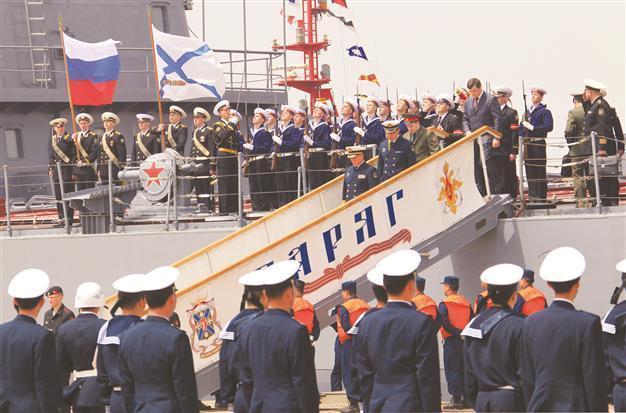US not alone in Asia-Pacific
BEIJING

Russian navy soldiers conduct ceremony on navy’s missile cruiser Varyag in Qingdao, China, during a joint military exercise in this April photo. Chinese President Hu
Jintao (inset R) shakes hands with Russian President Vladimir Putin in Beijing at the start of the Shanghai Cooperation Organization (SCO) summit. AP photo
Russian President Vladimir Putin said yesterday he would boost military cooperation with
China, including holding more joint exercises, after the United States announced plans to shift most of its warships to the Asia-Pacific by 2020.
Putin referred to recent Sino-Russian joint navy exercises in the Yellow Sea as an example of the kind of military cooperation that he said would go on. “We will also continue cooperation between our militaries,” he told Chinese Vice President Xi Jinping in Beijing, according to Reuters. Putin was in Beijing to attend a security summit and meet with his Chinese counterpart, Hu Jintao.
Putin’s statement came days after U.S. Defense Secretary Leon Panetta said the United States would reposition its naval fleet so that 60 percent of its battleships would be in the Asia-Pacific by the end of the decade, up from about 50 percent now.
Under the U.S. plans, Panetta announced that the Navy would maintain six aircraft carriers assigned to the Pacific. Six of its 11 carriers are now assigned to the Pacific, but that will fall to five when the USS Enterprise is decommissioned soon. The number will return to six when a new carrier, the USS Gerald R. Ford, is completed in 2015. “Recently, joint navy exercises were held in the Yellow Sea, and they were the first of such exercises. We have agreed with Chairman Hu that we will continue such cooperation,” Putin said.
Strengthening securityChinese and Russian naval forces held six days of exercises in the Yellow Sea off China’s east coast in April, with drills including anti-submarine operations and the rescue of hijacked vessels.
China deployed 16 ships and two submarines, while
Russia sent four warships from its Pacific fleet. “We assign an important role to the joint initiative on strengthening security in the Asia-Pacific region and in this context we will maintain the relationship between our militaries,” Putin said in an earlier statement.
“We favor the formation of an open and equal-minded security and cooperation architecture in the region, based on the principles of international law,” he said. China and Russia have forged close economic and diplomatic ties following years of hostility and suspicion during the Cold War. Both look askance at the increased U.S. military involvement in what they view as their backyards.
USA,
